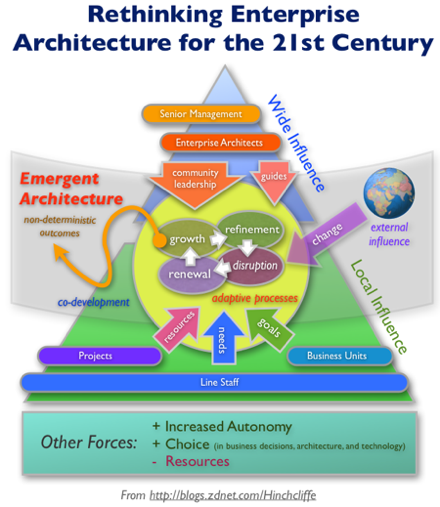Pragmatic new models for enterprise architecture take shape

The best outcomes result naturally from self-organizing thought leaders in an organization that seek each other out and collaborate on shared solutions to their problems.Hear the words "enterprise architecture" and many people will turn away automatically. It's not that they aren't aware that technology drives so much of the modern world, they just think it doesn't apply to what they do. The famous IT/business divide is too often kept this way because of mutual incomprehension, not-invented-here thinking, and apparently incompatible mindsets. However, this is beginning to change.
High technology continues to relentlessly pervade practically every aspect of today's business world, prescribing what is potentially possible and often conferring enormous leverage when harnessed fully. But it has been the advent of the Web 2.0 era and its inexorable movement (some might even say infiltration) into the workplace that is making traditional IT -- and the master planning version of it, enterprise architecture -- an entirely new beast by popularizing simple, egalitarian tools and approaches that can be understood and applied more easily and quickly by a broad audience across most organizations.
Increasingly, in some IT departments and business units around the world, a closer new relationship is forming in which technology is deeply interwoven into continuous joint business processes of creation, change, and adaptation. Like so many grassroots tech culture movements, this one doesn't yet have a formal name, but increasingly some are calling it emergent architecture.
The first seeds of this change began to be felt with advent of agile development processes a few years ago along with the subsequent rise of software mashups, and the popularity of user-distributable widgets, badges, and gadgets. These technology approaches combined with emerging business trends such as tacit interactions and pull-based systems driven from with bottom-up within organizations, particularly when co-existing with social computing and Enterprise 2.0.
The result: A new environment for creating technology-driven business solutions using different, more open communication channels with richer information and ground truth as well as significantly more adaptive technology elements often strongly influenced by the Web 2.0 world.
Meeting in the middle: Emergent Architecture
In recent years enterprise architecture has been moving from a discipline that provides top-down, a priori technology blueprints to the business side to one that articulates key, strategic possibilities and only the most critical high-level constraints (such as security standards) and then operates as a conductor, promoter, problem solver, and evangelist across the organization through the vehicle of a cohesive community to co-develop needed solutions.
When I wrote that most organizations were badly in need of a technology and software process "angioplasty" a few years ago, I highlighted the trends that will increasingly drive the agenda for new initiatives and projects when it comes to the strategic application of technology to business:
- Individuals and interactions over processes and tools
- Working software over comprehensive documentation
- Customer collaboration (internal or external) over contract negotiation
- Responding to change over following a plan
Enterprise architects of the near future will still dispense clear guidance that carries the requirements of the entire organization with it, but it will be appropriately broad and EAs will actively help tailor it to local needs across the organization. Self-service IT will become much more common as workers are comfortable using today's extremely easy-to-use, adaptive, and flexible tools, many of them using Web 2.0 ideas such as simple, open architectures and malleable pieces and parts, especially open APIs, and even new, open business models such as crowdsourcing and community-based involvement.
While organizations such as Gartner are just beginning to map this trend, there's increasingly little doubt that the infamous chasm that often disconnects IT and business is being crossed in many quarters by business users unafraid of today's populist technologies combined with IT practitioners that strongly desire to solve immediate and important business problems. That today's collaborative and communication technologies in the workplace are much more open, social and collaborative than they were even a couple of years ago are likely to be responsible to a considerable degree for the growth of this trend. The refinement and improved understanding of the power of emergent solutions that respond better to change, create blended responses to widespread organizational needs with local ones, and deal with disruption explicitly just makes more efficient use of resources and better software solutions to business problems.
6 aspects of Emergent Architecture
Here the key aspects of emergent architecture that seem to be the most significant in terms of productivity, timeliness, effectiveness, and innovation:
- Community-driven architecture. The growth of online communities within organizations are allowing workers to come together and solve problems in a much more ad hoc fashion and respond to change and opportunities more quickly than ever before. Technical architecture is also melding with business architecture to a higher degree than before in community settings, reflecting a more cosmopolitan make-up of solution participants and broader, non-technical inputs.
- Autonomous stakeholders. Workers and projects have more freedom to make business, design, and technology decisions. The center of the organization can now monitor, engage, and/or participate more easily at the edge to ensure its essential requirements are met, but otherwise get out of the way of progress.
- Adaptive processes. In today's much more continuous and intense environments with tremendous streams of real-time information, businesses are increasingly required to respond quickly to suddenly developing conditions that are both highly impactful and well outside the traditional (read: lengthy) response times of traditional solutions development. Adaptive processes use change as a key input and also expect disruption and other unusual forms of input and even outright interference as normal. The key is to flexibly introduce frequent course corrections that respond appropriately to external changes. This rapidly often leads to multiple emergent outcomes to solve problems that are uncovered, teased apart, and then dealt with along the way.
- Resource constraints. Web startups have long discovered that too many resources ensures that enormous waste is allowed, even encouraged. Scarce resources encourages reuse, collaboration, sharing, and innovation in solving problems. Resource excess tends to encourage autonomy and not-invented-here thinking and drives the motivation out of many emergent outcomes. The "less is more" mantra seems to be very true when it comes to information rich, yet resource balanced environments.
- Decentralized solutions. The result of applying emergent architecture tends to be a software solution well-integrated across the systems and involving many data sources and other organizational attributes of value (in particular, its people). Emergent architecture naturally results in mashups and similar lightweight, highly composite SOA solutions that build upon existing resources to solve new business problems. Silos can still form and political fiefdoms can still block global progress, but the increased visibility of environments favorable to emergent architecture encourage the opposite.
- Emergent outcomes. The highly deterministic outcomes of traditional, directed IT solutions are being replaced by many more numerous but smaller solutions that tackle the large problems in a more distributed, organic though still systemic manner.
We are entering a post-modern era of enterprise architecture that the advent of initiatives like SOA actually helped usher in. As I observed as this trend began a few years ago:
Invariably, the best architecture I see comes naturally from self-organizing thought leaders in an organization that seek each other out and collaborate on common solutions to their problems. Rather than the us vs. them mentality of old-world enterprise architecture, there is only an us mentality. Instead of prescribed standards, designs, technologies, and tools there is real [two-way] consensus and immediate buy-in.
To get a better sense of what is going on, I'll be taking a look at specific examples of emergent architecture over the next few months and presenting the most compelling examples here. I'd also be delighted to hear about new projects that have any of the attributes above. Finally, to get a sense of how this field is developing, a great place to start is Brad Appleton's new list of Emergent Design and Evolution Architecture resources.
How do you see enterprise architecture changing in your organization? Please respond in Talkback below.
